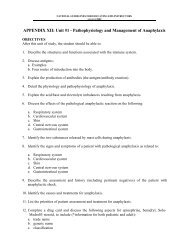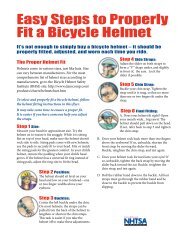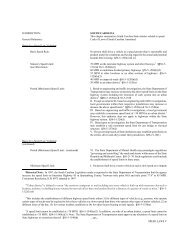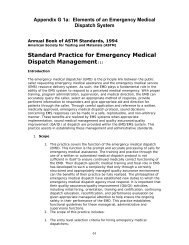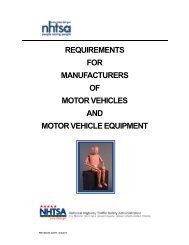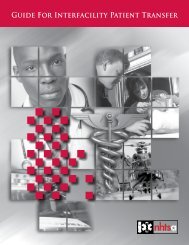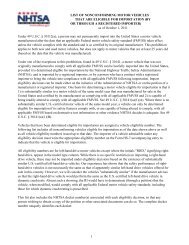The Criminal Justice System: A Guide for Law Enforcement ... - NHTSA
The Criminal Justice System: A Guide for Law Enforcement ... - NHTSA
The Criminal Justice System: A Guide for Law Enforcement ... - NHTSA
Create successful ePaper yourself
Turn your PDF publications into a flip-book with our unique Google optimized e-Paper software.
TOXICOLOGISTS<br />
<strong>The</strong> prosecutor will ask you what you did with the sample in this case:<br />
• What was the condition of the blood/urine sample (explain the condition it<br />
was in when received—sealed, clearly labeled, no signs of tampering, etc.)?<br />
• Did you follow established lab protocols—rules—when conducting the tests?<br />
• Please provide a brief, non-scientific description of the lab instruments used.<br />
• What were the results—cocaine, methamphetamine, etc. present?<br />
• If urine, explain how long prior to the taking of the sample the drug was in the<br />
blood and thus affecting the person’s brain.<br />
• Explain the effects of the drug on a person (sleepy, hyper, hard to concentrate,<br />
slows reaction times, etc.).<br />
• Explain the potential <strong>for</strong> wide variations in a drug’s effect—new versus<br />
experienced user, amount taken (over what period of time), other drugs being<br />
used at the same time (“synergistic effect” 1 + 1 > 2), “going up” or “coming<br />
down” off the drug.<br />
• Discuss the physical and mental abilities needed to safely drive a car.<br />
• Discuss how the effects of the drug interfere with driving a car (e.g., delayed<br />
reaction time means the driver is slower to notice (even in split seconds) the<br />
light turning from green to red; and in that split second of not braking, the car<br />
has traveled further down the road.<br />
• Are you able to give an opinion that on this date, at this time, this defendant<br />
was impaired by this drug to a degree that made him unable to drive safely?<br />
<strong>The</strong> Need to Use Ordinary Language<br />
Part of your job in testifying is to take a potentially complex or unfamiliar term<br />
and convert it into ordinary language. While you won’t be testifying to a group of<br />
kindergarten children, it is helpful to think back to your late grade school/early high<br />
school days and the vocabulary you used at that time. Common toxicology terms defined<br />
in laymen’s terms include:<br />
Route of Administration - how the drug gets into the person’s body<br />
• Oral - taken by mouth; swallowed<br />
• Inhalation - breathed in through nose and/or mouth<br />
• Intravenous - injected with a needle, similar to getting a shot at the doctor’s office<br />
• Smoking - as with a cigarette, cigar, or pipe but perhaps in another <strong>for</strong>m, such as a<br />
small glass tube open at both ends to suck smoke through one’s mouth<br />
• Intranasal – drug placed directly into the nose where it is absorbed by the skin<br />
inside the nose and breathed in deeply<br />
• Dermal - through the skin, as with a patch used to quit smoking<br />
Absorption - getting the drug into the body (following “route of administration”)<br />
20



